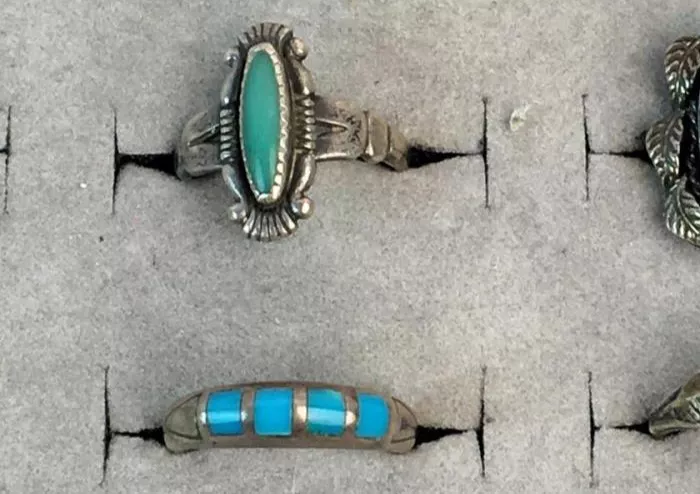Turquoise rings are beautiful and meaningful pieces of jewelry. But how much do they cost? The price of a turquoise ring can vary greatly. Some rings sell for $20, while others can cost thousands.
In this guide, we will explore the factors that affect the value of a turquoise ring. We will discuss:
- The quality of the turquoise stone
- The type of metal used in the ring
- The craftsmanship and design
- The origin of the turquoise
- Whether the ring is vintage or modern
- The reputation of the seller
By the end, you will know how to determine the worth of a turquoise ring.
What Affects the Value of a Turquoise Ring?
Several factors influence the price of a turquoise ring. Here are the most important ones:
The Quality of the Turquoise Stone
Turquoise is graded based on color, hardness, and purity.
Color
The most valuable turquoise is a pure, bright sky blue (often called “Persian blue”).
Greenish-blue turquoise is less expensive.
Yellow or brown streaks (called “matrix”) can lower the value unless they create an attractive pattern.
Hardness & Durability
High-quality turquoise is hard and dense.
Soft, chalky turquoise is cheaper but less durable.
Treatments & Enhancements
Natural turquoise (untreated) is the most valuable.
Stabilized turquoise (treated with resin to harden it) is common and affordable.
Dyed or fake turquoise (howlite or plastic) is very cheap but not genuine.
The Metal Used in the Ring
The metal setting affects the price:
Sterling silver rings are the most common and affordable (20−300).
Gold (10K, 14K, 18K) rings are more expensive (200−2,000+).
Platinum rings are rare and costly ($1,000+).
Craftsmanship & Design
Handmade rings (by Native American or artisan jewelers) cost more.
Mass-produced rings (factory-made) are cheaper.
Intricate designs (filigree, inlay, or carved details) increase the price.
Origin of the Turquoise
Turquoise from certain mines is more valuable:
Persian (Iranian) turquoise – The rarest and most expensive.
Sleeping Beauty (Arizona) turquoise – Bright blue, no matrix, highly prized.
Kingman (Arizona) turquoise – Known for its deep blue color.
Chinese turquoise – Often cheaper but can still be beautiful.
Vintage vs. Modern Rings
Vintage turquoise rings (especially from the 1900s) can be collectible and expensive.
Modern rings vary in price depending on quality.
Brand & Seller Reputation
Luxury brands (Tiffany & Co., David Yurman) charge premium prices.
Native American artists (like Navajo or Zuni silversmiths) sell authentic, handmade rings at fair prices.
Online marketplaces (Etsy, eBay) offer a wide range, but quality varies.
How Much Do Turquoise Rings Cost? (Price Ranges)
Here’s a general price guide for turquoise rings:
| Type of Turquoise Ring | Price Range |
|---|---|
| Cheap, mass-produced (dyed howlite or plastic) | 10−50 |
| Stabilized turquoise in silver (factory-made) | 30−150 |
| Natural turquoise in silver (handmade) | 100−500 |
| High-quality turquoise in gold (Sleeping Beauty, Persian) | 300−2,000+ |
| Vintage/Native American turquoise rings | 200−5,000+ |
| Luxury designer turquoise rings (Tiffany, Cartier) | 1,000−10,000+ |
How to Tell If a Turquoise Ring Is Valuable
Not all turquoise rings are worth the same. Here’s how to spot a valuable one:
Check the Turquoise Quality
Color:
Bright blue is best. Green or chalky turquoise is cheaper.
Hardness:
High-quality turquoise is smooth and hard, not powdery.
Matrix:
Some people like the veining (matrix), but too much can lower value.
Look for Authenticity
Natural turquoise feels cold and heavy.
Fake turquoise (plastic or dyed howlite) feels light and warm.
Stabilized turquoise is common but should be disclosed by the seller.
Examine the Metal
Sterling silver should be stamped “925.”
Gold should have a stamp (10K, 14K, 18K).
Platinum is marked “PT” or “950.”
Research the Seller
Reputable jewelers provide certification.
Native American artists often sign their work.
Avoid scams by buying from trusted sources.
Where to Buy a Turquoise Ring (Best Places)
You can find turquoise rings in many places, but some are better than others:
Jewelry Stores
Pros: Trusted, can inspect in person.
Cons: Higher prices, limited selection.
Native American Art Markets
Pros: Authentic, handmade, supports artists.
Cons: May be expensive, harder to find.
Online (Etsy, eBay, Specialty Sites)
Pros: Wide selection, competitive prices.
Cons: Risk of fakes, can’t inspect before buying.
Auctions & Estate Sales
Pros: Can find rare vintage pieces.
Cons: Requires knowledge to avoid overpaying.
How to Care for Your Turquoise Ring
Turquoise is softer than diamonds or sapphires, so it needs proper care:
Avoid water & chemicals (perfume, lotion, cleaning products).
Store separately to prevent scratches.
Clean gently with a soft, dry cloth.
Re-polish occasionally if the stone loses shine.
Conclusion
The price of a turquoise ring depends on:
- Stone quality (color, hardness, origin)
- Metal type (silver, gold, platinum)
- Craftsmanship (handmade vs. mass-produced)
- Brand & seller reputation
Budget option: 50−200 (stabilized turquoise in silver)
Mid-range: 200−1,000 (natural turquoise, handmade)
High-end: $1,000+ (Persian/Sleeping Beauty turquoise, gold settings)
If you want a genuine, high-quality turquoise ring, expect to pay at least 100−500. For investment-grade or luxury pieces, prices go into the thousands.
Always buy from a trusted seller and check for authenticity. A real turquoise ring can last a lifetime and even increase in value over time.
Related topics:
Is Turquoise Precious or Semiprecious?
How Much Is Turquoise Worth Per Gram? A Complete Guide
African Turquoise: The Remarkable Properties & Benefits


